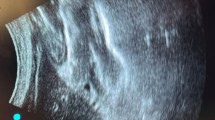Abstract
A combined manometric and radioisotope study is described which was designed to investigate the motility characteristics of induced defaecation in the colon, rectum and anal canal, in patients with severe constipation. Five women with severe idiopathic constipation, aged 30–45 years, were studied. A multiple channel water-perfused manometric tube was placed colonoscopically into either the whole colon or left colon to monitor pressure activity. In two whole-colon studies, 5.5 MBq 111In DTPA and later 9 MBq 99mTc DTPA were instilled into the colon to monitor the transit of colonic contents in response to two separate stimuli. Motor activity was initiated on both occasions by intraluminal instillation of 5.5 mg bisacodyl. In the whole-colonic studies a right colonic stimulus initiated multiple high-pressure peristaltic waves which traversed the entire length of the colon. The bowel was then refractory to a second stimulus at the splenic flexure. In the five left colonic studies, a stimulus at the splenic flexure produced high-pressure peristaltic waves which proceeded distally, and which included a rise in rectal pressure. The anal canal relaxed simultaneously with the onset of peristalsis high in the left colon, and remained relaxed until the pressure wave reached the anus and bowel content had been expelled. In both types of study high-pressure waves corresponded to the effective transport of radioisotope. The constipated patients showed a coordinated motor response to the stimulus. The passage of flatus coincided with a simultaneous pressure rise in the distal colon and rectum, together with anal relaxation. These findings confirm previous observations that the defaecation induced by a luminal stimulant consists of colonic peristalsis, rectal contraction, and early anal relaxation. The ability to generate this sequence of motor activity is preserved in patients with severe idiopathic constipation.
Résumé
Une manométrie combinée à une étude par radioisotopes est décrite qui fût établie pour étudier les caractéristiques de la motilité de la défécation provoquée dans le colon, le rectum et le canal anal chez des patients avec une constipation sévère. 5 femmes avec une constipation idiopathique sévère, âgées de 30 à 45 ans, ont été étudiées. Une sonde manométrique à plusieurs canaux perfusées par de l'eau, a été placée sous coloscopie soit dans tout le colon, soit dans le colon gauche pour enregistrer les activités de pressions. Dans deux études complètes du colon, 5,5 MBq In-111 DTPA et plus tard 9 MBq 99m-Tc DTPA ont été instillés dans le colon afin d'enregistrer le transit du contenu colique en réponse à 2 stimulis séparés. L'activité motrice a été déclenchée dans les deux cas par l'instillation intra-luminale de 5,5 mg de Bisacodyl. Dans les études portant sur tout le colon, un stimulus dans le colon droit provoquait de multiples ondes péristaltiques de haute pression qui traversaient la totalité du colon. L'intestin était ensuite réfractaire à un second stimulus à l'angle splénique. Dans les 5 études portant sur le colon gauche, une stimulation au niveau de l'angle splénique provoquait des valves péristaltiques de haute pression qui se propageaint de façon distale et provoquaient une augmentation de la pression rectale. Le canal anal se relâchait simultanément avec le début du péristaltisme dans le colon gauche, et demeurait relâché jusqu'à ce que l'onde de pression atteigne l'anus et que le contenu intestinal ait été expulsé. Dans les deux types d'études les ondes de haute pressions correspondaient à un transport effectif de radioisotopes. Les patients constipés montraient une réponse motrice coordonnée aux stimulus. Le passage de gaz coincidait avec une augmentation simultanée de la pression dans le colon distal et le rectum associée a un relâchement anal. Ces résultats confirment les observations précédentes que la défécation provoquée par un stimulant intra-luminal est due à un péristaltisme colique, une contraction rectale et un relâchement anal précoce. La possibilité de provoquer cette séquence motrice est conservée chez les patients atteints de constipation idiopathique sévère.
Similar content being viewed by others
References
Narducci F, Bassotti G, Gaburri M, Morelli A (1978) Twenty four hour manometric recording of colonic activity in healthy man. Gut 28:969–973
Matsueda K, Yamato S, Kojima Y, Muraoka A, Kosaka H, Shimojo E, Umeda N, Oda T (1988) A new hypothesis on pathophysiology of diarrhoea and constipation types of irritable bowel syndrome. Gastroenterology 94:290
Bazzocchi G, Ellis J, Villanueva-Meyer J, Jing J, Reddy SN, Mena I, Snape WJ (1990) Postprandial colonic transit and motor activity in chronic constipation. Gastroenterology 98:686–693
Karaus M, Sarna SK (1987) Giant migrating contractions during defecation in the dog colon. Gastroenterology 92:925–933
Kamm MA, Van der Sijp JRM, Lennard-Jones JE (1992) Colorectal and anal motility during defaecation. Lancet 339:820
Bassotti G, Gaburri M, Imbimbo BP, Rossi L, Farroni F, Pelli MA, Morelli A (1988) Colonic mass movements in idiopathic chronic constipation. Gut 29:1173–1179
Hinton JM, Lennard-Jones JE, Young AC (1969) A new method for studying gut transit times using radio-opaque markers. Gut 10:842–847
Halls J (1965) Bowel content shift during normal defaecation. Proc R Soc Med 58:859–860
Goyall RK, Cobb BW (1981) Motility of the pharynx, esophagus, and esophageal sphincters. In: Johnson LR (ed) Physiology of the gastrointestinal tract. Raven, New York, pp 359–391
Christensen J (1987) Motor functions of the pharynx and oesophagus. In: Johnson LR (ed) Physiology of the gastrointestinal tract. Raven, New York, pp 595–612
Schang JC, Devroede G (1988) Myoelectric propagating spike bursts in the sigmoid colon elicit the rectoanal inhibitory reflex. Gastroenterology 94:A:403
Preston DM, Lennard-Jones JE (1985) Pelvic motility and response to intraluminal bisacodyl in slow-transit constipation. Dig Dis Sci 30:289–294
Author information
Authors and Affiliations
Rights and permissions
About this article
Cite this article
Kamm, M.A., van der Sijp, J.R.M. & Lennard-Jones, J.E. Observation on the characteristics of stimulated defaecation in severe idiopathic constipation. Int J Colorect Dis 7, 197–201 (1992). https://doi.org/10.1007/BF00341220
Accepted:
Issue Date:
DOI: https://doi.org/10.1007/BF00341220




